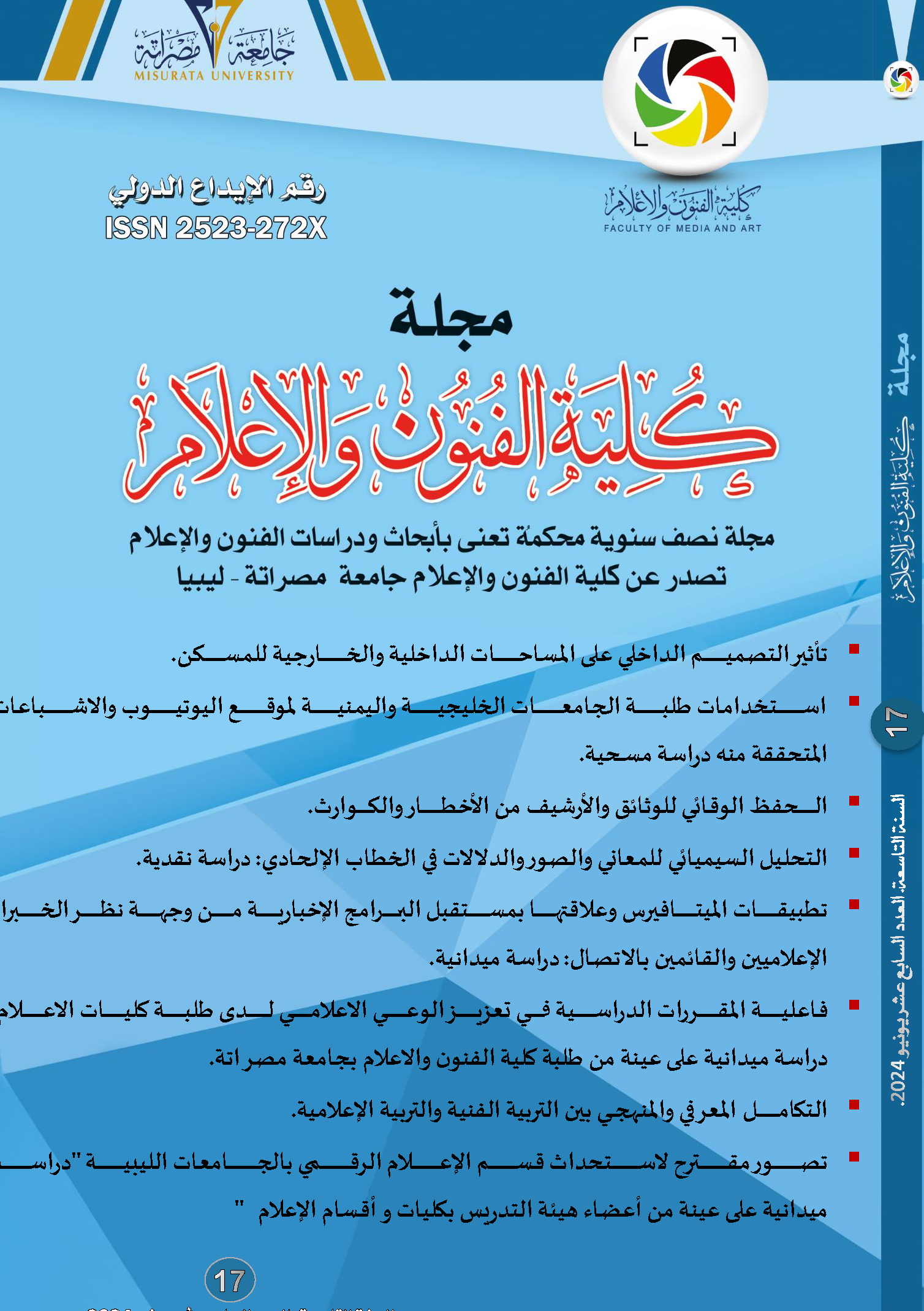Challenges facing the use of the metaverse in news programs from the point of view of media experts and those communicating with the State of Libya” A field study.
DOI:
https://doi.org/10.36602/famj.2024.17.5Keywords:
Metaverse applications, News Program, Media Experts - Communication Guides.Abstract
The study aimed to reveal the most important concepts associated with metaverse technology and identify the most important technologies related to it and their relationship to the future of news programs by monitoring, analyzing and interpreting the vision of a sample of media experts and those responsible for communicating with news programs towards the future of those programs in light of the expansion of the procedure for employing metaverse technology, as well as monitoring changes and impacts. What these technologies can create on news programs and the features of their future in terms of the form of the message, the nature of the content, the target audience, and the characteristics of the communicator as a result of using these technologies, in addition to developing possible future scenarios for the use of metaverse technology in news programs, within the framework of the theory of acceptance and use of technology, Relying on the questionnaire tool, it was applied to (60) individual experts (professors of media departments and colleges in Libyan universities, Department of Media, Omar Al-Mukhtar University, Department of Media, University of Derna, College of Media, University of Benghazi, College of Media, University of Ajdabiya, and the category of professionals included the communicator in Al-Hadath Channel, Al-Masar Channel, and Radio Tobruk and Al Umma Radio) using the Delphi method and morphological analysis to identify possible future scenarios for the future of the news program industry in light of metaverse technologies. The results of the study concluded that the reformist or creative scenario was dominated by the optimistic (to a large extent) reformist or creative scenario for employing metaverse technology in news programs, at a rate exceeding more than half of the number of respondents, as it came at a rate of (73.3%), followed in second place by the directional or linear scenario. The reference scenario (with a moderate degree) at a rate of (20%), followed in order by the scenario of collapse or pessimistic transformation (at a low degree) at a rate of (6.7%). The respondents expected quantitative and qualitative growth and prosperity for Libyan news programs in light of metavirus technologies. The results also demonstrated the presence of A statistically significant correlation between your acceptance of metaverse technology in news programs and the effect of using metaverse technology in news programs, at a significance level (0.000). The study recommended the need to create media jobs that are compatible with the nature and functions of metaverse technologies, and to modernize newsrooms to keep pace with various technological developments.
References
1. Kour, M., & Rani, K. (2023). “Challenges and Opportunities to the Media and Entertainment Industry in Metaverse”. Applications of Neuromarketing in the Metaverse, P.P.88-102. DOI: 10.4018/978-1-6684-8150-9.ch007
2. Wang, L.(2023), "Communication: From the Internet to the Intelligent", Journal of Intelligent Communication Vol(1), Issue(1), P.P.1-20..
3. Vicente, P, (2022), "After the Hype: How Hi-Tech Is Reshaping Journalism", Total Journalism, Studies In Big Date 97,Vol (14), No(7), P.P.41-59. ISSN 2197-6503
4. Qian Pon le., (2022), "Emloying Metaverse Technology in the Newspaper", Journal of Media Business Studies, Vol(33), No(8), January 2022, P.P 234-250.
5. Bernt Kim ( 2022 ), “Application in the Robot , metaverse , xr techniqhes in the press” , theses phd degree , school of media communication , korea university .
6. Irem Yeniceler kortak's, (2022), "Investion of the News from the National and International Press About Metaverse Technology", P.hD, Published by Dokuz Eylul University Greadute School of Socal Sciences.
7. Daewon Fanta ( 2021 ), “Application of metavirs in media organization” , Digital journalism , Vol(7), No(3) , P.P 163 – 180 .
8. كامل، ايناس محمود (2023)، "اتجاهات الصحفيين المصرين نحو استخدام تقنيات الميتافيرس في الصحافة المصرية وتأثيرها على صناعة الصحافة"، مجلة البحوث الإعلامية، العدد (66)، الجزء الثاني، جامعة الأزهر، كلية الإعلام، يوليو2023، ص ص 953-1020.
9. البحيري، شيرين (2023)، "تعرض الإعلاميين المصريين لتقنية الميتافيرس Metaverse عبر المواقع الإعلامية العربية والأجنبية واتجاهاتهم نحوها"، المجلة المصرية لبحوث الإعلام، العدد (82)، جامعة القاهرة، كلية الإعلام، مارس 2023، ص ص 1-40.
10. عبد الظاهر، محمد (2022)، "صحافة الجيل السابع وما هو أبعد من إعلام الميتافيرس: كيف يمكن تطبيق ميتافيرس في التسويق الروبوتي؟ دراسة استطلاعية، مؤسسة صحافة الذكاء الاصطناعي للبحث والاستشراف، الإمارات، دبي، يناير 2022، ص ص 1-36.
11. علي، شفق أحمد علي ( 2022)، " تغطية تقنية ميتافيرس في عينة من الفيديوهات العربية ولإنجليزية على اليوتيوب: دراسة تحليلية كيفية"، مجلة البحوث الإعلامية، العدد (63)، الجزء الأول ، جامعة الأزهر، كلية الإعلام، أكتوبر 2022، ص ص 101- 168.
12. بريك، أيمن محمد ابراهيم (2022)، "تطبيقات الميتافيرس وعلاقتها بمستقبل صناعة الصحافة الرقمية: دراسة استشرافية خلال العقدين القادمين 2022: 2042"، المجلة المصرية لبحوث الإعلام، العدد (78)، جامعة القاهرة، كلية الإعلام، مارس 2022، ص ص 45- 76.
13. بومشطة ، نوال (2022)، "توظيف تكنولوجيا الواقع المعزز في إنتاج التقارير الإخبارية عبر القنوات الفضائية العربية: قناة سكاي نيوز عربية نموذجا"، مجلة العلوم الإنسانية، مجلد (9)، العدد (3)، جامعة أم البواقي، الجزائر، ص ص 718-735.
14. Hossein Nassaji. (2015). “Qualitative and descriptive research: Data type versus data analysis”, Language Teaching Research, Vol (19). No (2). p.129.-
15. Isaac, S., & Michael, W. B. (1997). نHandbook in research and evaluation: A collection of principles, methods, and strategies useful in the planning, design, and evaluation of studies in education and the behavioral sciences". (3rd Ed.). San Diego: Educational and Industrial Testing Services.p.136.
16. Saritas, O., Burmaoglu, S. (2015) The evolution of the use of Foresight methods: a scientometric analysis of global FTA research output. Scientometrics 105, 497– 508 https://link.springer.com/article/10.1007/s11192-015-1671-x -
17. Grime, M. M., & Wright, G. (2016). Delphi method. Wiley StatsRef: Statistics Reference Online, 1, 16.
18. MinhTuan Nguyen & Madeleine Dunn. (2009). “Some Methods for Scenario Analysis in Defenses Strategic Planning", Joint Operations Division Defence Science and Technology Organization. Commonwealth of Australia, p.13.
19. Hannah Kosow & Robert Gaßner. (2008). “Methods of Future and Scenario Analysis. Overview, Assessment, and Selection Criteria", DIE Research Project “Development Policy: Questions for the Future”. German Development Institute, p.10. -
20. زاهر، ضياء الدين (2004)، "مقدمة في الدراسات المستقبلية"، (القاهرة: مركز الكتاب للنشر)، ص0.6- ، نهي حسين محمد محمود (2021)، "اتجاهات الخبراء نحو مستقبل دمج تطبيقات الذكاء الاصطناعي في الاتصالات التسويقية المتكاملة للشركات المصرية: دراسة استشرافية"، مجلة بحوث العلاقات العامة الشرق الأوسط، ( القاهرة: الجمعية المصرية للعلاقات العامة)، العدد 35، أكتوبر، ص ص 71-133.
21. Álvarez, A., & Ritchey, T. (2015). Applications of general morphological analysis. Acta Morphologica Generalis, Vol(4).No(1) - https://www.swemorph.com/pdf/amg-4-1-2015.pdf
22. Feng, Xu & Fuhai, Leng (2012). "Patent Text Mining and Informetricbased Patent Technology Morphological Analysis: An empirical Study", Technology Analysis & Strategic Management, Vol,)24(. No.5, p.468.
23. M.Stenström, P. Westrin & Tom Ritchey, (2004). "Living with UXO - Using Morphological Analysis for Decision Support in Phasing out Military Firing Ranges. Summary of Report, The Swedish Armed Forces UXO Program: Stockholm.p.13.
أسماء السادة محكمي استمارة الاستبيان مرتبة أبجدياً:
أ. سعيد عبد المنعم الدسوقى، أستاذ الإعلام المشارك بالمعهد العالي للإعلام وفنون الاتصال 6 أكتوبر – مصر.
ب. على عجوة، أستاذ العلاقات العامة والإعلان بكلية الإعلام جامعة القاهرة – مصر.
24. عبد المعطي، هند عبد المهدي (2022)، "مدى تقبل الصحفيين لاستخدام الطائرات بدون طيار Drones بمجال 43 الصحافة وتأثيرها على مستقبلهم الوظيفي- دراسة استطلاعية"، مجلة البحوث الإعلامية، العدد(60)، الجزء الأول ، جامعة الأزهر، كلية الإعلام، ، ص 319.
25. George A.S et al, (2021). Metaverse: The Next Stage of Human Culture and .24 the Internet, International Journal of Advanced Research Trends in Engineering and Technology (IJARTET), Vol.(8), No.(12), Dec.,2021, ISSN 2394-3777.
26. Hovan George S, Maschio Femando, Shaji George A & Dr T Baskar (2021). "Metaverse: The Next Stage of Human Culture and the Intemet", International Journal of Advanced Research Trends in Engineering and Technology (IJARTET), Vol. 8, Issue 12, p.1
27. نور الدين ، زعتر (2022)، "العالم الافتراضي الميتافيرس Metaverse من منظور سيكولوجي"، مجلة العلوم الإنسانية، جامعة أم البواقي، الجزائر، المجلد(9)، العدد(2)، ص 1018.
28. عبد العزيز، أحمد عبد المجيد (2021)، مستقبل الصحافة المصرية في ظل تقنيات صحافة الذكاء الاصطناعي خلال العقد القادم (في الفترة من 2021 حتى 2030)- دراسة استشرافية، مجلة البحوث الإعلامية، (جامعة الأزهر: كلية الإعلام، العدد58، الجزء3، يوليو)، ص 1397-1458.











